Episcopalians follow Way of the Cross out of churches to pray at Lenten stations in their communitiesPosted Mar 19, 2018 |
|
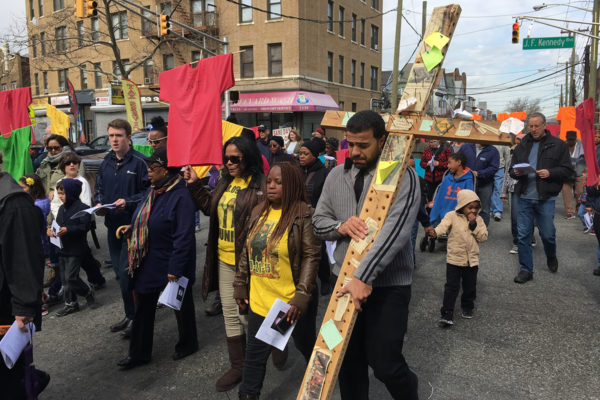
Episcopalians in Jersey City, New Jersey, lead a public procession for Stations of the Cross at sites of violence in the city on Good Friday 2017. Photo: St. Paul’s Episcopal Church
[Episcopal News Service] Praying the Stations of the Cross during Lent is a centuries-old tradition that focuses Christians on the path of suffering that Jesus followed to his ultimate sacrifice on the cross, and for many Christians, that story is retold in solemn tones inside the walls of a church or chapel.
Some Episcopal congregations, however, have followed the Way of the Cross out the cathedral and church doors and into the community for public liturgies that often connect the details of Jesus’ Passion with contemporary examples of injustice and persecution.
Such liturgies, held each year from New Jersey to Louisiana, also allow worshipers to publicly witness to their Christian faith.
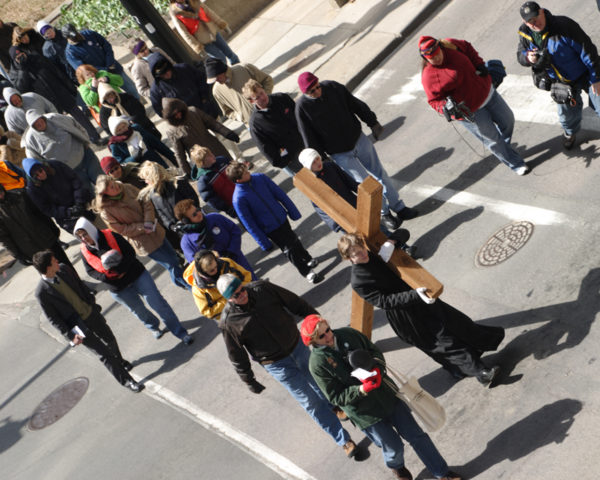
The Episcopal Cathedral Church of St. Paul is one of four Christian congregations in downtown Des Moines, Iowa, that have organized a Way of the Cross procession each year for more than a decade. Photo: William J. Gentsch
“What we do is we read the station, and then different people are invited ahead of time to formulate a very short reflection, and typically, that reflection ties the reading to the site where we’re reading and contemporary issues,” said the Rev. John Doherty, a deacon and administrator at Cathedral Church of St. Paul in Des Moines, Iowa, where he participates in the annual Way of the Cross procession through the city’s downtown.
The Rev. Audra Abt, missionary vicar at Episcopal Church of the Holy Spirit in Greensboro, North Carolina, helps organize a similar Good Friday procession that serves to brings the story of Jesus’ suffering into a present-day context.
“If we do it outside the church, we can’t help but see how that suffering continues,” she said. “I think it transforms us as people of faith and calls us to put ourselves where Jesus was.”
Praying the Way of the Cross, though not a solely Episcopal devotion, is outlined in the Episcopal Church’s Book of Occasional Services. The book provides biblical readings and prayers for each of the 14 stations, from the first, “Jesus is condemned to death,” to the final, “Jesus is laid in the tomb.” Congregations often hang pictures on church walls depicting Jesus in each of the 14 stations, so worshipers can process from station to station around the church.
There are no geographical limitations, however, and following the Way of the Cross as an outdoor procession evokes early Christian history, when worshipers, starting in the fourth century, followed what was believed to be the actual path of Jesus through Jerusalem.
“A winding route emerged over time from the ruins of Antonia Fortress, held to be where Jesus stood before Pilate, then west to the basilica,” according to a history of the Stations of the Cross produced by Baylor University. “Eventually stops developed, and in 1342, Franciscan monks were given official custody of these holy sites, closely identifying them with the stations from then on, in the Holy Land.”
The number of stations has varied widely over the years, sometimes reaching as many as 37, as Catholic News Agency notes, and the term “stations” was first applied to these devotions in the 15th century.
“Along that way of suffering Jesus’ every meeting – with friends, with enemies, with the indifferent – is a chance for one final lesson, one last look, one supreme offer of reconciliation and peace,” the Vatican says in its online presentation on the Way of the Cross.
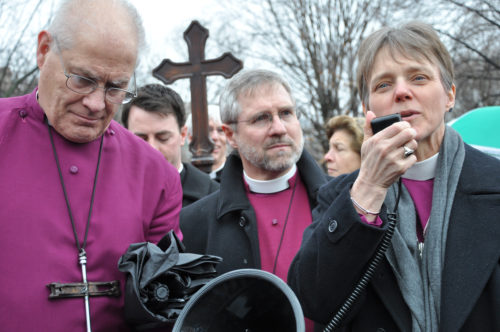
Episcopal Diocese of Washington Bishop Mariann Edgar Budde, right, recites prayers at the first Way of the Cross station March 21, 2013, in Washington, D.C. Diocese of Connecticut Bishop Suffragan James Curry, left, and Connecticut Bishop Ian Douglas listen. ENS photo/Mary Frances Schjonberg
It was a lesson that Episcopalians took to Washington, D.C., in March 2013 when they prayed the Way of the Cross in a march against gun violence after the December 2012 massacre of 26 students and educators at Sandy Hook Elementary School in Newtown, Connecticut. Organizers meant for the procession to send a powerful message to friends, enemies and the indifferent, though congregations need not have a specific issue in mind to plan an outdoor Way of the Cross.
The annual Des Moines liturgy is organized by a partnership between the Episcopal cathedral and the downtown Lutheran, Methodist and Roman Catholic congregations. It has been held every Good Friday for more than a decade, with turnout ranging from 30 to 60 people, depending largely on the weather.
“We actually do carry or pull the cross from station to station,” Doherty said, explaining that the large wooden cross that leads the procession has a wheel on the bottom.
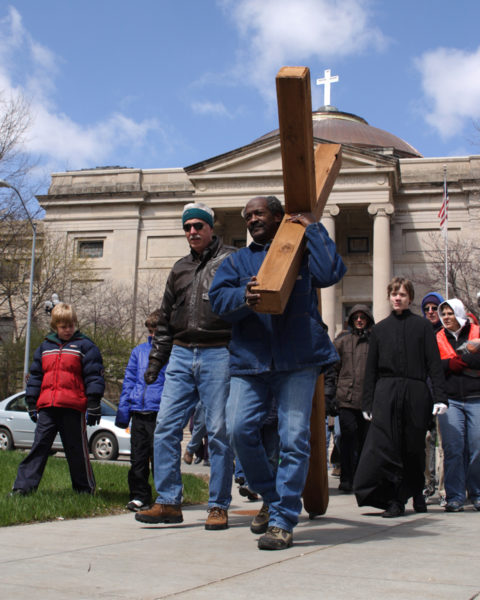
The annual Good Friday procession in downtown Des Moines, Iowa, is led by someone pulling a large wooden cross on wheels. Photo: William J. Gentsch
Those leading the prayers at the stop in front of the Des Moines jail reference Jesus being brought before the council to be condemned, Doherty said. At another stop, in front of a public housing complex, the group may contemplate Jesus’ call to minister to the poor.
“It’s a public display or witness of our faith, and also to remind people that it’s Good Friday – it’s not just another Friday,” Doherty said. The Way of the Cross also is a time “to recall, as much as we can get our head around it, what the crucifixion, the sacrifice of Christ really means to us in contemporary society.”
The core devotional experience remains consistent from Des Moines to Greensboro, though each public Way of the Cross is tailored to the local community. Some congregations draw direct connections between the stations and the sites. Others see the public liturgy more generally as a spiritually rich form of evangelism. The following are some examples from around the country.
Jersey City, New Jersey
This Good Friday will mark the fourth year the three Episcopal churches in Jersey City will pray at Stations of the Cross that are located at the sites of violence in the city from the past year. The processions have grown to about 150 people, including members of the Jersey City Police Department, which provides the list of locations.
“What we wanted to do was to figure out a way to have a public witness and also a way to make holy places that had been touched by violence,” said the Rev. Tom Murphy, rector at St. Paul’s Episcopal Church.
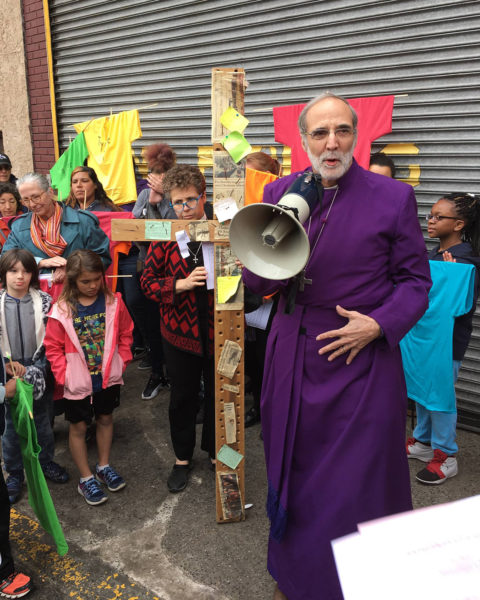
Diocese of Newark Bishop Mark Beckwith speaks at one of the stations in the April 14, 2017, Way of the Cross procession in Jersey City, New Jersey. Photo: St. Paul’s Episcopal Church
At first, it was difficult to explain to police officials what the churches were trying to accomplish, Murphy said, but the department has become a partner and even participates in the event.
“One of the years, the captain of the precinct was right at the front of the procession, and several times over the course of it he said he could visualize the people who had been killed at each of the locations,” Murphy said.
Part of the procession involves a blessing for the police force, and individual officers are invited to step forward to receive personal blessings. Newark Bishop Mark Beckwith also has participated in each of the past three years, as have members of other Christian denominations.
Murphy describes the day as powerful and moving, made more so by the fact that the procession sometimes has encountered residents who knew the victims of violence highlighted by the route. The message to those residents, Murphy said, is that the church cares and is engaged in the community beyond what takes place in traditional worship spaces.
“On Good Friday, we remember the suffering of Jesus of Nazareth, but if Jesus is really in our brothers and sisters, Jesus continues to suffer in what happens to people on the streets and homes in our city,” he said.
Greensboro, North Carolina
The public Stations of the Cross in Greensboro, North Carolina, also is in its fourth year. It grew out of a conversation between clergy and lay leaders at three Episcopal churches in the area. They wanted a Stations of the Cross that anyone downtown would be welcome to join.
Abt called it “a very vulnerable and humble evangelism.” The Good Friday event has maintained a minimalist and even impromptu feel. In the first year, some stations didn’t even have prayers ready, so some of the participants volunteered to lead extemporaneous prayers. Last year, about 60 people joined the procession.
“We had this intuition that Stations of the Cross would be something that would draw people … but that we didn’t have to over plan it,” Abt said. “People came wanting to offer something. It’s almost like we created the container and we created this liturgy of the Way of the Cross and were open to whatever people were willing to offer.”
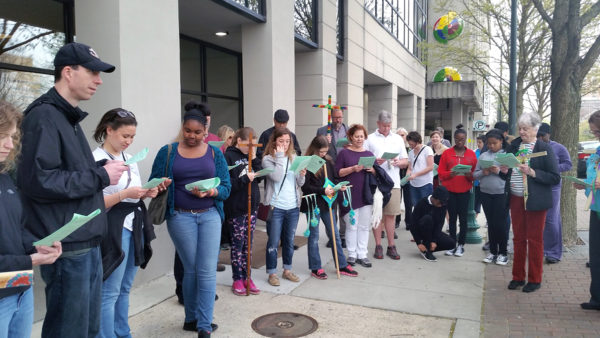
Participants stop at one of the stations in the 2016 Way of the Cross procession in Greensboro, North Carolina. Photo: Audra Abt.
The organizers also shy away from drawing too direct of a connection between the moment in Jesus’ final journey depicted in each station and the places in Greensboro chosen for each stop. At the same time, participants have noted parallels at certain local landmarks.
One such landmark is the site of the Woolworth’s lunch counter where four black college students in 1960 staged a sit-in against segregation, a pivotal event in the civil rights movement. Another stop that resonates with worshipers is the Family Justice Center, which serves victims of domestic violence and abuse.
“I’ve watched there as people connect the sorrow of the women [of Jerusalem] to the sorrow and the anguish and the resilience of people who have survived domestic violence,” Abt said.
Covington, Louisiana
This is the second year that Christ Episcopal Church in Covington, Louisiana, is leading an outdoor Way of the Cross in partnership with a Presbyterian church. A procession was held March 4, and another will be offered March 21.
The church has adopted a Lenten focus on racial relationships this year, so organizers plotted a mile-long route that showed the city’s diversity by passing through different neighborhoods, some predominantly black and others predominantly white.
“We said, this year when we do stations, we need to make sure we’re walking in both parts of town,” said the Rev. Anne Maxwell, associate rector.
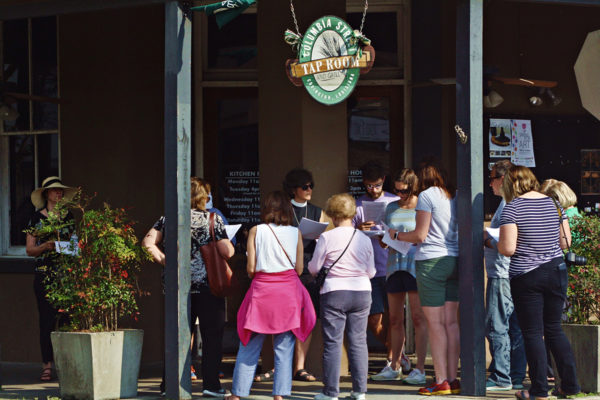
The Way of the Cross, led by the Rev. Anne Maxwell, center in clergy collar, stops at a station in front of the Columbia Street Tap Room and Grill in Covington, Louisiana, in 2017. Photo: Karen Mackey/Diocese of Louisiana
The liturgy for the stations was written to reference various social justice issues, but Maxwell said this Stations of the Cross still will feel familiar. Participants are encouraged to contemplate their faith beliefs while applying them to present-day society: “How does culture speak to the church, and how does church speak to the culture?”
Simply being visible in the community is doing the work of God, she said.
“If we’re hiding in our church, then we don’t have a voice in current affairs,” she said. “And at the same time, there’s something timeless and faithful in walking the Stations of the Cross.”
Atlanta, Georgia
All Saints’ Episcopal Church in Atlanta has a new rector, the Rev. Simon Mainwaring, and after its Good Friday service, All Saints’ is trying a public Stations of the Cross for the first time around its bustling midtown neighborhood.
“In a lot of ways, we’re seeking to locate the church amidst the vitality of the city we see around us,” Mainwaring said. Residents of multimillion-dollar condos pass people sleeping in doorways amid the din of new construction. The sense of movement here is constant, as people file in and out of the nearby Fox Theater and the subway station.
Mainwaring hopes the procession’s participants will bring a newfound “theological imagination” the next time they pass through this neighborhood.
“I see public liturgy like this as an act of reimagining society around us,” he said. “It’s planting these little seeds. … It’s not a presence that is loud and obnoxious on the street corner, but it’s also clearly a Christian presence.”
All Saints’ has brought that Christian presence outside the church before, from its Ashes to Go ministry on Ash Wednesday to caroling outside the subway station during Advent. The Way of the Cross, meanwhile, has something specific to say about a social landscape where power differentials affect the struggle for justice.
“Good Friday is a day when grace meets the violence of the world,” he said. In addition to recounting Jesus’ earthly suffering, “it connects to our ultimate questions of where is the divine in this struggle?”
– David Paulsen is an editor and reporter for the Episcopal News Service. He can be reached at dpaulsen@episcopalchurch.org.

Social Menu